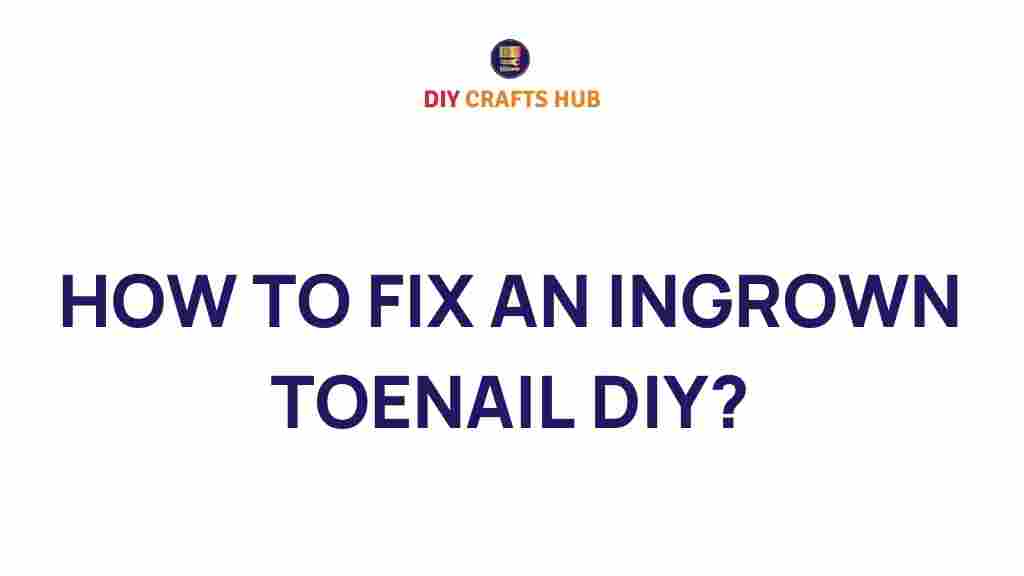

How to Fix an Ingrown Toenail at Home
Dealing with an ingrown toenail can be a painful and frustrating experience. Left untreated, it can lead to infections and other complications. Fortunately, in many cases, you can address the issue at home with simple remedies and proper care. This guide will walk you through the step-by-step process of fixing an ingrown toenail safely and effectively.
What Is an Ingrown Toenail?
An ingrown toenail occurs when the edge or corner of a toenail grows into the surrounding skin. This condition typically affects the big toe and can cause redness, swelling, and discomfort. If not managed promptly, an ingrown toenail may become infected, resulting in severe pain and pus discharge.
Common Causes of Ingrown Toenails
- Improper nail trimming, such as cutting nails too short or at an angle
- Wearing tight or ill-fitting footwear
- Injury to the toenail or repeated stress
- Genetic predisposition or naturally curved nails
- Poor foot hygiene
Step-by-Step Guide: How to Fix an Ingrown Toenail at Home
Follow these steps to treat an ingrown toenail at home. Always ensure your tools and hands are clean to prevent infections.
1. Soak Your Foot
Begin by soaking your foot in warm, soapy water for 15-20 minutes. This helps soften the nail and reduces swelling. Adding Epsom salt to the soak can further alleviate discomfort and reduce inflammation.
2. Gently Lift the Nail
After soaking, carefully lift the ingrown edge of the nail using a clean cotton ball or dental floss. Place a small piece of cotton or gauze under the nail to separate it from the skin. This encourages the nail to grow above the skin instead of into it.
3. Apply an Antibacterial Ointment
To prevent infection, apply a thin layer of antibacterial ointment to the affected area. Cover it with a sterile bandage to protect the toe from dirt and bacteria.
4. Choose Comfortable Footwear
Avoid tight or pointed shoes that can worsen the ingrown toenail. Opt for open-toe or loose-fitting footwear during the healing process to minimize pressure on the affected area.
5. Trim Your Nails Correctly
Once the inflammation subsides, trim your nails straight across to prevent future issues. Avoid cutting the nails too short or rounding the edges.
6. Monitor for Signs of Infection
If the area becomes more swollen, red, or begins to ooze pus, consult a healthcare professional immediately. These are signs of infection that require medical attention.
Troubleshooting Tips for Ingrown Toenails
Even with proper care, you may encounter challenges while treating an ingrown toenail. Here are some troubleshooting tips:
- Persistent Pain: Try soaking your foot multiple times a day and using over-the-counter pain relievers.
- Recurrent Ingrown Toenails: Consult a podiatrist for permanent solutions, such as partial nail removal.
- Infections: Apply an antibiotic ointment and monitor the area closely. Seek medical advice if symptoms worsen.
When to See a Doctor
While most cases of ingrown toenails can be managed at home, professional help may be necessary in the following situations:
- Severe pain that doesn’t improve
- Signs of infection, such as pus, fever, or increasing redness
- Recurring ingrown toenails
- Underlying health conditions like diabetes that impair healing
If you’re unsure about your symptoms, it’s better to consult a healthcare provider. You can learn more about advanced treatments for ingrown toenails at WebMD.
Preventing Ingrown Toenails
Prevention is always better than cure. Here’s how you can minimize the risk of developing an ingrown toenail:
- Trim nails straight across and avoid rounding the edges
- Wear properly fitting shoes with enough room for your toes
- Practice good foot hygiene by keeping your feet clean and dry
- Inspect your feet regularly, especially if you’re prone to ingrown nails
For additional foot care tips, check out our comprehensive guide on maintaining healthy toenails.
Conclusion
Fixing an ingrown toenail at home is possible with patience and the right approach. By soaking your foot, lifting the nail gently, and taking preventive measures, you can manage the condition effectively. However, never hesitate to seek medical advice if the situation worsens or doesn’t improve. Proper care and attention will keep your feet pain-free and healthy in the long run.
This article is in the category DIY Tools and created by DIYCraft Team
Recent Posts
Transform Your Space: How to DIY a Stunning Bench
Discover how to DIY a stunning bench that enhances your home decor and adds functionality.…
Unveiling the Secrets: How to Make Your Own DIY Scratch-Offs
Discover how to make DIY scratch-offs that add a unique touch to your gifts and…
Master the Art of Burning Letters into Wood: A DIY Journey
Discover how to burn letters into wood with our DIY guide, perfect for personalized gifts…
The Art of Asking: Creative Ways to Invite Your Bridesmaids
Discover creative ways to ask someone to be your bridesmaid with unique DIY invitations that…
Can You DIY an Inground Pool? Unveiling the Secrets to Success
Discover if you can DIY an inground pool with our expert tips and insights on…
Discover Effective Strategies to Prevent Grey Water Odors at Home
Learn how to manage grey water and prevent odors with these DIY solutions for a…